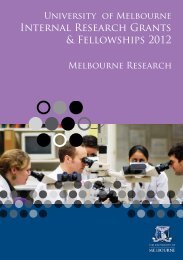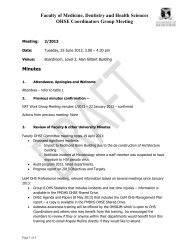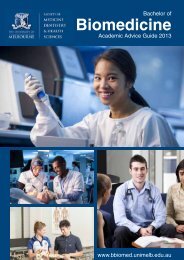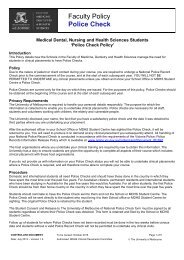A Body of Evidence: An Art Historical perspective on Eighteenth and ...
A Body of Evidence: An Art Historical perspective on Eighteenth and ...
A Body of Evidence: An Art Historical perspective on Eighteenth and ...
Create successful ePaper yourself
Turn your PDF publications into a flip-book with our unique Google optimized e-Paper software.
Introducti<strong>on</strong><br />
The Harry Brookes Allen Museum, the museum <str<strong>on</strong>g>of</str<strong>on</strong>g> anatomy at the University <str<strong>on</strong>g>of</str<strong>on</strong>g><br />
Melbourne, is the embodiment <str<strong>on</strong>g>of</str<strong>on</strong>g> scientific detachment. The floor is highly<br />
polished; the doors <strong>and</strong> display cabinets are without any ornament. These<br />
elements underscore the didactic purpose <str<strong>on</strong>g>of</str<strong>on</strong>g> this museum. Human body parts<br />
preserved in alcohol, or ‘wet models’ 1 are the most prominent <strong>and</strong> featured<br />
exhibits, but there are also eight wax anatomical models. These anatomical<br />
models are <str<strong>on</strong>g>of</str<strong>on</strong>g> a different epoch from the wet models that date to the 1950s. The<br />
models are delicately executed in tinted wax; either supported by turned wooden<br />
pedestals or laid out <strong>on</strong> carefully arranged treated cloth. 2 Many dem<strong>on</strong>strate the<br />
internal workings <str<strong>on</strong>g>of</str<strong>on</strong>g> specific areas <str<strong>on</strong>g>of</str<strong>on</strong>g> the human body such as the h<strong>and</strong> or ear<br />
canal. One particularly arresting model is <str<strong>on</strong>g>of</str<strong>on</strong>g> a dissected infant showing the<br />
brightly coloured abdominal cavity <strong>and</strong> organs (Fig.1). The delicacy <strong>and</strong> the<br />
external finish <str<strong>on</strong>g>of</str<strong>on</strong>g> these models is quite different to the approach taken in<br />
anatomical drawings <strong>and</strong> models from more recent periods that are also in the<br />
collecti<strong>on</strong>. The juxtapositi<strong>on</strong> <str<strong>on</strong>g>of</str<strong>on</strong>g> these models, to unadorned scientific objects<br />
within an anatomy museum, illustrates the progressive establishment <str<strong>on</strong>g>of</str<strong>on</strong>g><br />
medicine as a discipline.<br />
1 These specimens were collected during the 1950’s <strong>and</strong> c<strong>on</strong>sist <str<strong>on</strong>g>of</str<strong>on</strong>g> various body parts suspended in a fixing<br />
soluti<strong>on</strong> within sealed perspex boxes.<br />
2 See attached appendix for detailed descripti<strong>on</strong> <str<strong>on</strong>g>of</str<strong>on</strong>g> each model.












